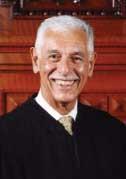US v. Cruz, No. 03-35873 (9-16-05). Unsurprisingly, the 9th holds that Booker "does not apply retroactively to convictions that became final prior to its publication." The 9th joins all the other circuits that have considered this issue in finding that Booker does not meet the Teague exceptions: it is a "new rule" that is "procedural" and is not a watershed rule. The 9th decides this in a slight per curiam opinion. While undoubtedly the decision was foretold, the issue is not as easy as the analysis would have it. Justice O'Connor, in Apprendi, stated that the decisions were "watershed." Moreover, the distinction between Ring and Booker is not who makes the decision, but also, critically, by the difference between reasonable doubt and preponderance.
US v. Kortgaard, No. 03-10421 (9-21-05). The 9th wrestles with another Booker/Ameline issue, this time delaing with an upward departure based upon underrepresentation of criminal history. The defendant here had numerous drug and property crime convictions that either weren't counted because they were stale or because they were foreign. The district court departed upward because he found that the defendant's track record indicated he would commit further crimes. The 9th was troubled with this propensity approach. It remand through because under Ameline the court had sentenced under a mandatory scheme, even with an upward, and that the new advisory guides rendered the system more flexible. The 9th rejected the gov't's argument that the convictions evaded Ameline because they were under the Almendarez-Torres exception (past convictions). The 9th stated that a conviction is one thing, but the facts surrounding the conviction, especially in characterizing it and using it for sentencing, was intensely factual, and had to be reconsidered in a remand. The 9th restated that need for the court identify why these priors should result in the sentence it did. Prior convictions aren't simply tallied up, but need to be assessed for seriousness and for quality, not quantity.
Sims v. Brown, No. 03-99007 (9-21-05). The 9th affirms the denial of habeas relief. The petitioner stalked Domino pizza employees because of an argument, and committed several murders in South Carolina and one in California, with attempted murders as well. The murder was strangulation after calling for a pizza, and then robbing the store. The key issues here revolved around the prosecutor striking various minority jurors, statements admitted in violation of Miranda, and in arguing that the jury, in sentencing, should not consider the horrific sexual, physical and emotional childhood abuse of the petitioner because there was no "bridge" to this crime. The 9th concluded that the prosecutor has offered race neutral reasons why he struck so many African American and Hispanic jurors (youth, limited life experiences, hostility to the death penalty). The 9th also concluded that it didn't have to decide whether statements made by petitioner were in violation of his Miranda rights (he invoked, but late made some statements, and the issue was whether they were spontaneous or a result of police questioning) because any error was harmless. Finally, the 9th held that the argument of tying the abuse to the offense still allowed the jury to consider the abuse as mitigation; it was an argument why it didn't matter. B. Fletcher, dissenting, argues that the incriminating statement ("I had to kill that boy") was in violation of Miranda because the petitioner had simply asked, after he had invoked, what the process of extradition was, and this lead the officer to pry. Moreover, under a Brecht analysis, the statement was prejudicial because the prosecutor harped on it in his closing argument. The prosecutor also erred in imposing a tie between the abuse and the crime, while the law permits any mitigation to be presented, not requiring a tie.
US v. Chaudry, No. 04-50421 (9-14-05). The 9th holds that the drilling of a single hole 5/16th of an inch into the bed of a pickup truck at the border did not constitute a property search that is "so destructive as to require a different result." US v. Flores-Montano, 541 US 149 (2004). This was a border POE search. The hole was small, it didn't result in making the truck unsafe, nor in destroying the property. The gov't in this case, and two others, pressed a litigation position that the gov't doesn't need reasonable suspicion, or any suspicion, in order to drill and search. Judges B. Fletcher and Fisher concurred, stressing that the gov't had suspicion in this case because of the alert of drugs, and that the gov't was seeking, in effect, an advisory opinion obviating the need for any suspicion. They characterized the litigation strategy as "game playing" and a waste of judicial resources. Under the facts of this case, they upheld the district court but their patience was tried.
US v. Hernandez, No. 04-50286 (9-14-05). Essentially the same as Chaudry as the removal of door panels were not obtrusive or destructive.
US v. Flores-Montano, No. 04-50497 (9-14-05). Essentially the same as Chaudry except the search was of a gas tank. This trilogy of cases offer a roadmap of how the gov't can drill, poke, pry, and dismantle a vehicle at the border, without suspicion, in order to see if there is contraband.



